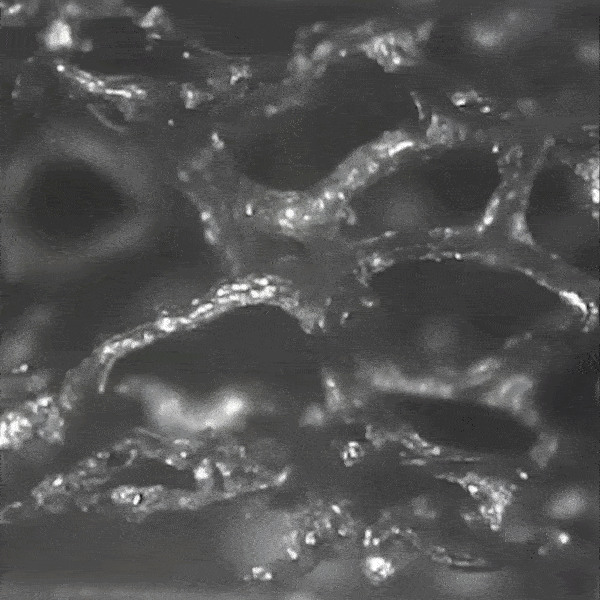
Zixin Xiong, a Purdue University PhD candidate in mechanical engineering, studies thermal transport at high temperatures in the Marconnet Thermal and Energy Conversion Lab. Purdue professor Xiulin Ruan and associate professor Amy Marconnet have invented patent-pending, solid-state, continuously tunable thermal devices to dissipate heat from batteries, insulate them against cold and function across a wide range of temperatures. (The ESC Plan photo/Charles Jischke)
Patent-pending invention is more versatile than conventional thermal switches with only two discrete settings
WEST LAFAYETTE, Ind. – Battery safety and performance in electronic devices and systems like battery thermal management, space conditioning, vehicle thermal comfort and thermal energy storage can improve thanks to a continuously tunable thermal regulator created at Purdue University's College of Engineering.
Xiulin Ruan and Amy Marconnet have invented patent-pending, solid-state, continuously tunable thermal devices based on compressible graphene foam composites. The devices can dissipate heat, insulate against cold and function across a wide range of temperatures. Ruan is a professor in the School of Mechanical Engineering. Marconnet is an associate professor in the School of Mechanical Engineering and a Perry Academic Excellence Scholar; she also has a courtesy appointment in the School of Materials Engineering.
"As batteries and electronic devices get more powerful, managing heat becomes a more crucial issue," Ruan said. "We all know humans have a narrow range of temperature to live comfortably, and that is why we wear shirts in the summer to keep cool and coats in the winter to keep warm. Similarly, batteries and electronic devices have a narrow temperature range to function appropriately as well, and are even more 'picky' than humans."
Marconnet said, "Batteries perform poorly if they are too hot. As they heat up, chemical reactions occur that cause them to heat up even faster. This unstable reaction progression is called 'thermal runaway' and can even lead to fires and explosions. On the other hand, if the temperatures are too low, batteries suffer internal damage. It leads to poor performance like shorter driving ranges for electric vehicles and less cellphone usage time."
Conventional thermal switches, analogous to electrical switches that moderate current flow, tune a battery's heat dissipation pathways only by changing the conduction between on and off states. Ruan said the Purdue-invented thermal regulators improve upon this technology by changing the thickness of the material inside the regulators, which helps batteries continually adjust to different climates and seasons.
"Unlike people being able to put on a coat when it is cold or a swimsuit when it is warm, a battery wears the same 'clothes' everywhere with conventional thermal management technology," Marconnet said. "By using the thermal regulator to adjust the pathway between a battery and the environment, we can insulate the battery in cold conditions and make it very easy to dissipate heat in warm ones."
The commercially available compressible graphene foam Ruan and Marconnet use is built from nanoscopic particles of carbon deposited in a specific pattern with small voids of air in between. When it is uncompressed, the foam acts as an insulator; air pockets keep the heat in place. When it is compressed, air escapes and heat is conducted throughout. The amount of heat transfer can be precisely dialed in depending on how much the foam is compressed.
Marconnet and Ruan measured the foam's thermal conductance at Purdue's Birck Nanotechnology Center. They sandwiched a 1.2-millimeter-thick sample of graphene foam in between a heater and heat sink, and placed the system under an infrared microscope to measure the temperature and heat flow. When they fully compressed the foam to a thickness of 0.2 millimeters, the thermal conductance went up by a factor of 8. They also conducted an experiment in a chamber at Purdue's Flex Lab that can create specific environmental conditions and achieved similar results with ambient temperatures from zero degrees Celsius (32 degrees Fahrenheit) to 30 degrees Celsius (86 degrees Fahrenheit).
 Purdue University researchers Xiulin Ruan and Amy Marconnet have studied compressible graphene foam to develop a continuously tunable thermal regulator. (Purdue University image/Tingting Du)
Purdue University researchers Xiulin Ruan and Amy Marconnet have studied compressible graphene foam to develop a continuously tunable thermal regulator. (Purdue University image/Tingting Du) Ruan said the patent-pending regulators were initially created for electric vehicles' batteries, but there are other applications.
"The same approach could be applied to sensors and detectors for scientific or industrial applications that need to be maintained at precise temperatures, as well as electronic devices across a range of applications," Ruan said. "It may also help maintain appropriate temperature for space vehicles, which face harsh environments of extreme heat and cold."
Ruan and Marconnet's research was published in two peer-reviewed journals. The battery application research was published in the Aug. 13, 2021, issue of Nature Communications; the fundamental research was published in the Oct. 18, 2022, issue of ACS Applied Materials & Interfaces.
Ruan and Marconnet disclosed the thermal regulators to the Purdue Research Foundation Office of Technology Commercialization, which applied for patent protection on the intellectual property. Industry partners interested in further developing the technology for the marketplace should contact Dhananjay Sewak






